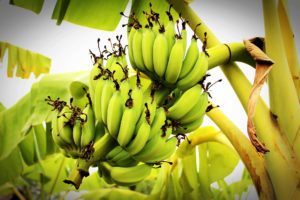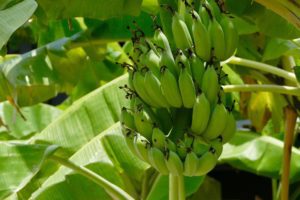Once I planted my first windowsill banana tree, I was hooked. Sure, bananas are low on my favorite flavors list, as far as fruit goes. But this TREE. This fantastic, gorgeous TREE. It was easy to care for, incredibly fast-growing, uniquely beautiful and an impressive conversation piece. It was easy to grow, yet challenging to convince it to set fruit, giving my gardening skills a workout without adding stress that the tree would die on me. Pruning needs were essentially zero, and the easy task of trimming off the brown leaves offered instant beautification of the tree with no guesswork as to whether I was doing it “right.”
Even better, there are so many varieties to choose from – and lucky for us gardeners, starting a banana tree can be done with a seed packet, not just by purchasing a baby tree though the internet or in a local greenhouse. If you’ve ever wanted to grow a windowsill banana tree but weren’t sure if starting from seeds was right for you, read on!
GROWING WINDOWSILL BANANAS FROM SEED

Yes, you CAN grow a banana tree from seed… but think about what you are doing before you sail ahead. Consider the grocery-store bananas you typically eat. Do you ever find crunchy seeds within the fruit? Never (or at least I hope not!). Grocery-store bananas are seedless varieties, propagated from pups or plant suckers.
Logically, it follows that if you plant banana seeds, you are going to end up with fruit that is NOT seedless. Now, a seeded banana plant will be every bit as gorgeous as its seedless cousins – but the edibility will struggle a bit. Banana seeds are hard, and you don’t want to break a tooth on what is supposed to be soft and squashy smoothie-material. Yes, you can eat seeded bananas, but they should be mashed through a strainer to remove these pebble-like little seeds first, so just be aware that a seeded fruit variety will be more work than a seedless banana at harvest time.
TIPS FOR GERMINATING BANANA SEEDS
If you have decided to start from seed, you are going to need to put in some extra work to make sure the seeds germinate. Banana seeds have very tough shells, and the germination rate tends to be very low. Prepping in advance can be very helpful. If you soak the seeds in warm water (not hot water! You don’t want a hard-boiled banana seed!) for 24-36-hours before planting, that pre-soaking can give the seed a jump start towards germination.
Scarification is often necessary for a banana seed. In the natural environment, seed coatings are often compromised by trauma or by being eaten by birds or other animals. In a home-grown environment, you may need to mimic this natural trauma to the hard, protective shell. Try a little sandpaper against the edge of the hard shell (not damaging the eye of the seed). Lightly wearing down the shell with sandpaper or making a tiny nick in the shell can both improve germination rates and speed up the germination process.
After soaking and scarification, I would recommend placing the seeds on a wet paper towel or napkin and trying germination within a plastic Ziploc baggie before transferring to potting soil. This transparent baggie will help you keep an eye on which seeds are germinating and which are duds, and saves invaluable windowsill space from being cluttered up by seed-starting pots that will never produce a plant.
FINAL STEPS IN PLANTING BANANA SEEDS

When sprouting, keep the seeds warm. A heat mat for seedlings is ideal; keep that met underneath your baggie or plant-starter pots until the seed has sprouted. Once the seed has sprouted, you can carefully transfer to a soilless growing medium, such as seed-starting or potting mix. Don’t remove the heat mat until the baby seedling has firmly established itself with a solid root system. Although relatively hardy as they grow older, a young seedling is very fragile, and the heat mat provides a welcome boost of stability while the seedling builds its strength.
If you are struggling to grow banana seeds, you are in good company! Because the tree typically propagates itself by rooting new suckers along the base, the seeds don’t have the need to be as aggressive as seeds from other trees. The germination rate is commonly very, very low… so don’t assume that you’ve done something wrong if your first few tries don’t end in success. Sometimes it isn’t a “practice makes perfect” situation – it’s more of a statistical problem, and sooner or later you will come out on top!
GROWING POTTED BANANA TREES INDOORS
It took me a long time to warm up to the idea of growing windowsill banana trees, but once I tried, they won me over faster than a little golden retriever puppy could have. Today, I can’t imagine my windowsill garden without at least a handful of banana trees, and being able to grow from seed gives me a cheaper option to add to those varieties. Although seeded varieties have less culinary value than a seedless type does, they still are gorgeous plants and they can be eaten if you are careful to take care of the seeds along the way. This makes planting from seed a lower-risk option; if your seeds don’t germinate, you have the consolation of knowing that the variety wouldn’t be the best option for fresh eating anyway, and on top of that, you haven’t spent your hard-earned money on a started sucker.
I still love my windowsill citrus trees – but I have to admit that if I had to select just one tree for my windowsill, there’s a very good chance I’d go with the banana… and the only question is what cultivar I would choose! The care for an indoor banana tree is pretty reasonable, too; if you’re looking for some expert advice, you can skim this article on how to grow bananas from Texas Ag Extension. It’s not specific to growing potted banana trees on a windowsill, but the tips on outdoor banana cultivation are still easily “extrapolated” for indoor use.
Not ready to experiment with seeds but unsure where to purchase a banana pip? Check out my favorite windowsill fruit tree nurseries!